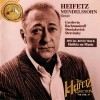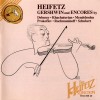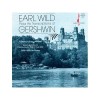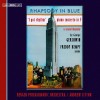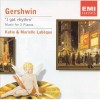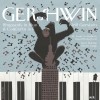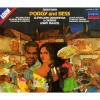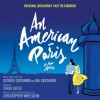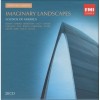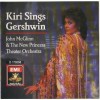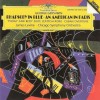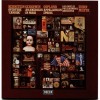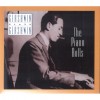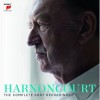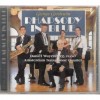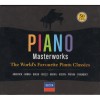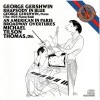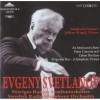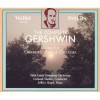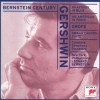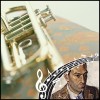Biography
George Gershwin (September 26, 1898 – July 11, 1937) was an American composer and pianist. Gershwin's compositions spanned both popular and classical genres, and his most popular melodies are widely known. Among his best known works are the orchestral compositions Rhapsody in Blue (1924) and An American in Paris (1928), as well as the opera, Porgy and Bess (1935).
He wrote most of his vocal and theatrical works, including more than a dozen Broadway shows, in collaboration with his elder brother, lyricist Ira Gershwin. George Gershwin composed music for both Broadway and the classical concert hall, as well as popular songs that brought his work to an even wider public. His compositions have been used in numerous films and on television, and many became jazz standards recorded in numerous variations. Countless singers and musicians have recorded Gershwin songs.
Gershwin was named Jacob Gershowitz at birth in Brooklyn, New York on September 26, 1898. His parents were Jews from Odessa (Ukraine). His father, Morris (Moishe) Gershowitz, changed his family name to 'Gershvin' some time after immigrating to the United States from St. Petersburg, Russia in the early 1890s. Gershwin's mother Rosa Bruskin had already immigrated from Russia. She met Gershowitz in New York and they married on July 21, 1895. George changed the spelling of the family name to 'Gershwin' after he became a professional musician; other members of his family followed suit.
George Gershwin was the second of four children. He first displayed interest in music at the age of ten, when he was intrigued by what he heard at his friend Maxie Rosenzweig's violin recital. The sound and the way his friend played captured him. His parents had bought a piano for lessons for his older brother Ira, but to his parents' surprise and Ira's relief, it was George who played it. Although his younger sister Frances Gershwin was the first in the family to make money from her musical talents, she married young and devoted herself to being a mother and housewife. She gave up her performing career, but settled into painting for another creative outlet; painting was also a hobby of George Gershwin.
Gershwin tried various piano teachers for two years, and then was introduced to Charles Hambitzer by Jack Miller, the pianist in the Beethoven Symphony Orchestra. Until Hambitzer's death in 1918, he acted as Gershwin's mentor. Hambitzer taught Gershwin conventional piano technique, introduced him to music of the European classical tradition, and encouraged him to attend orchestra concerts. At home, following such concerts, young Gershwin would attempt to reproduce at the piano the music that he had heard. He later studied with classical composer Rubin Goldmark and avant-garde composer-theorist Henry Cowell.
At the age of fifteen, George left school and found his first job as a performer, "song plugger" for Jerome H. Remick and Company, a publishing firm on New York City's Tin Pan Alley, where he earned $15 a week. His first published song was "When You Want 'Em You Can't Get 'Em, When You've Got 'Em, You Don't Want 'Em." It was published in 1916 when Gershwin was only 17 years old and earned him $5. His 1917 novelty rag "Rialto Ripples" was a commercial success, and in 1919 he scored his first big national hit with his song "Swanee" with words by Irving Caesar. In 1916, Gershwin started working for Aeolian Company and Standard Music Rolls in New York, recording and arranging. He produced dozens, if not hundreds, of rolls under his own and assumed names. (Pseudonyms attributed to Gershwin include Fred Murtha and Bert Wynn.) He also recorded rolls of his own compositions for the Duo-Art and Welte-Mignon reproducing pianos. As well as recording piano rolls, Gershwin made a brief foray into vaudeville, accompanying both Nora Bayes and Louise Dresser on the piano.
In the early 1920s Gershwin frequently worked with the lyricist Buddy DeSylva. Together they created the experimental one-act jazz opera Blue Monday set in Harlem, which is widely regarded as a forerunner to the groundbreaking Porgy and Bess.
In 1924, George and Ira Gershwin collaborated on a stage musical comedy Lady Be Good, which included such future standards as "Fascinating Rhythm" and "Oh, Lady Be Good!".
This was followed by Oh, Kay! (1926); Funny Face (1927); Strike Up the Band (1927 and 1930); Gershwin gifted the song with a modified title to UCLA to be used as a football fight song, "Strike Up The Band for UCLA". Show Girl (1929); Girl Crazy (1930), which introduced the standard "I Got Rhythm"; and Of Thee I Sing (1931), the first musical comedy to win a Pulitzer Prize (for Drama).
In 1924, Gershwin composed his first major classical work, Rhapsody in Blue for orchestra and piano. It was orchestrated by Ferde Grofé and premiered by Paul Whiteman's concert band in New York. It proved to be his most popular work.
Gershwin stayed in Paris for a short period of time during which he applied to study composition with the famous instructor Nadia Boulanger who, along with several other prospective tutors such as Maurice Ravel, rejected him, being afraid that rigorous classical study would ruin his jazz-influenced style. While there, Gershwin wrote An American in Paris. This work received mixed reviews upon its first performance at Carnegie Hall on December 13, 1928, but it quickly became part of the standard repertoire in Europe and the United States. Growing tired of the Parisian musical scene, Gershwin returned to the United States.
In 1929, Gershwin was contracted by Fox Film Corporation to compose the score for the movie Delicious. Only two pieces were used in the final film, the five-minute "Dream Sequence" and the six-minute "Manhattan Rhapsody". Gershwin became infuriated when the rest of the score was rejected by Fox Film Corporation, and it would be seven years before he worked in Hollywood again.
His most ambitious composition was Porgy and Bess (1935). Gershwin called it a "folk opera," and it is now widely regarded as one of the most important American operas of the twentieth century. "From the very beginning, it was considered another American classic by the composer of 'Rhapsody in Blue' — even if critics couldn't quite figure out how to evaluate it. Was it opera, or was it simply an ambitious Broadway musical? 'It crossed the barriers,' says theater historian Robert Kimball. 'It wasn't a musical work per se, and it wasn't a drama per se — it elicited response from both music and drama critics. But the work has sort of always been outside category."
Based on the novel Porgy by DuBose Heyward, the action takes place in the fictional all-black neighborhood of Catfish Row in Charleston, South Carolina. With the exception of several minor speaking roles, all of the characters are black. The music combines elements of popular music of the day, with a strong influence of Black music, with techniques typical of opera, such as recitative, through-composition and an extensive system of leitmotifs. Porgy and Bess contains some of Gershwin's most sophisticated music, including a fugue, a passacaglia, the use of atonality, polytonality and polyrhythm, and a tone row. Even the "set numbers" (of which "Summertime", "I Got Plenty o' Nuttin'" and "It Ain't Necessarily So" are well known examples) are some of the most refined and ingenious of Gershwin's output. For the performances, Gershwin collaborated with Eva Jessye, whom he picked as the musical director. One of the outstanding musical alumnae of Western University in Kansas, she had created her own choir in New York and performed widely with them.
After Porgy and Bess, Gershwin eventually was commissioned by RKO Pictures in 1936 to compose songs and the underscore for Shall We Dance, starring Fred Astaire and Ginger Rogers. Gershwin's extended score, which would marry ballet with jazz in a new way, runs over an hour in length. It took Gershwin several months to write and orchestrate it.
Early in 1937, Gershwin began to complain of blinding headaches and a recurring impression that he was smelling burned rubber. Doctors discovered he had developed a type of cystic malignant brain tumor known as glioblastoma multiforme. Although some tried to trace his disease to a blow on the head from a golf ball, the cause of this type of cancer is still unknown. It occurs most often in males, accounts for 52% of all brain cancers, and is nearly always fatal.
The diagnosis of glioblastoma multiforme has been questioned. The surgeon's description of Gershwin's tumor as a right temporal lobe cyst with a mural nodule is much more consistent with a pilocytic astrocytoma, a very low grade of brain tumor. Further, Gershwin's initial olfactory hallucination (the unpleasant smell of burning rubber) was in 1934. It is highly unlikely that a glioblastoma multiforme would cause symptoms of that duration prior to causing death. Pilocytic astrocytomas may cause symptoms for twenty or more years prior to diagnosis. Thus, it is possible that Gershwin's prominent chronic gastrointestinal symptoms (which he called his "composer's stomach") were a manifestation of temporal lobe epilepsy caused by his tumor. If this is correct, then[original research?] Gershwin was not "a notorious hypochondriac," as suggested by his biographer Edward Jablonski (who wrote, in a letter to the editor, that "Gershwin was a notorious hypochondriac, beginning as early as 1922, and his complaints were not taken seriously").
In January 1937, Gershwin performed in a special concert of his music with the San Francisco Symphony Orchestra under the direction of French maestro Pierre Monteux. Gershwin suffered "musical blackouts" during his final performances. It was in Hollywood, while working on the score of The Goldwyn Follies, that he collapsed. He died on July 11, 1937 at the age of 38 at Cedars of Lebanon Hospital following surgery for the tumor. John O'Hara remarked: "George Gershwin died on July 11, 1937, but I don't have to believe it if I don't want to." A memorial concert was held at the Hollywood Bowl on September 8, 1937 at which Otto Klemperer conducted his own orchestration of the second of Gershwin's Three Piano Preludes.
Gershwin received his sole Academy Award nomination, for Best Original Song, at the 1937 Oscars, for "They Can't Take That Away from Me" written with his brother Ira for the 1937 film Shall We Dance. The nomination was posthumous; Gershwin died two months after the film's release.
Gershwin had a ten-year affair with composer Kay Swift and frequently consulted her about his music. Oh, Kay was named for her. After Gershwin died, Swift arranged some of his music, transcribed some of his recordings, and collaborated with his brother Ira on several projects.
Gershwin died intestate. All his property passed to his mother. He is buried in the Westchester Hills Cemetery in Hastings-on-Hudson, New York. The Gershwin estate continues to collect significant royalties from licensing the copyrights on Gershwin's work. The estate supported the Sonny Bono Copyright Term Extension Act because its 1923 cutoff date was shortly before Gershwin had begun to create his most popular works. The copyrights on all Gershwin's solo works expired at the end of 2007 in the European Union, based on the life plus 70 years rule in force in the EU.
In 2005, The Guardian determined using "estimates of earnings accrued in a composer's lifetime" that George Gershwin was the wealthiest composer of all time.
Gershwin was influenced by French composers of the early twentieth century. In turn Maurice Ravel was impressed with Gershwin's abilities, commenting, "Personally I find jazz most interesting: the rhythms, the way the melodies are handled, the melodies themselves. I have heard of George Gershwin's works and I find them intriguing." The orchestrations in Gershwin's symphonic works often seem similar to those of Ravel; likewise, Ravel's two piano concertos evince an influence of Gershwin.
Gershwin asked to study with Ravel. When Ravel heard how much Gershwin earned, Ravel replied with words to the effect of, "You should give me lessons." (Some versions of this story feature Igor Stravinsky rather than Ravel as the composer; however Stravinsky confirmed that he originally heard the story from Ravel.)
Gershwin's own Concerto in F was criticized for being related to the work of Claude Debussy, more so than to the expected jazz style. The comparison did not deter Gershwin from continuing to explore French styles. The title of An American in Paris reflects the very journey that he had consciously taken as a composer: "The opening part will be developed in typical French style, in the manner of Debussy and Les Six, though the tunes are original."
Aside from the French influence, Gershwin was intrigued by the works of Alban Berg, Dmitri Shostakovich, Igor Stravinsky, Darius Milhaud, and Arnold Schoenberg. He also asked Schoenberg for composition lessons. Schoenberg refused, saying "I would only make you a bad Schoenberg, and you're such a good Gershwin already." (This quote is similar to one credited to Maurice Ravel during Gershwin's 1928 visit to France – "Why be a second-rate Ravel, when you are a first-rate Gershwin?")
Russian Joseph Schillinger's influence as Gershwin's teacher of composition (1932–1936) was substantial in providing him with a method of composition. There has been some disagreement about the nature of Schillinger's influence on Gershwin. After the posthumous success of Porgy and Bess, Schillinger claimed he had a large and direct influence in overseeing the creation of the opera; Ira completely denied that his brother had any such assistance for this work. A third account of Gershwin's musical relationship with his teacher was written by Gershwin's close friend Vernon Duke, also a Schillinger student, in an article for the Musical Quarterly in 1947.
What set Gershwin apart was his ability to manipulate forms of music into his own unique voice. He took the jazz he discovered on Tin Pan Alley into the mainstream by splicing its rhythms and tonality with that of the popular songs of his era. Although George Gershwin would seldom make grand statements about his music, he believed that "true music must reflect the thought and aspirations of the people and time. My people are Americans. My time is today."
In 2007, the Library of Congress named their Prize for Popular Song after George and Ira Gershwin. Recognizing the profound and positive effect of popular music on culture, the prize is given annually to a composer or performer whose lifetime contributions exemplify the standard of excellence associated with the Gershwins. On March 1, 2007, the first Gershwin Prize was awarded to Paul Simon.
Early in his career Gershwin made dozens of player piano piano roll recordings, which were a main source of income for him. Many are of popular music of the period and others are of his own works. Once his musical theatre-writing career took precedence, his regular roll-recording sessions dwindled. He did record additional rolls throughout the 1920s, including a complete version of his Rhapsody in Blue.
Compared to the piano rolls, there are few accessible audio recordings of Gershwin's playing. His first recording was his own Swanee with the Fred Van Eps Trio in 1919. The recorded balance highlights the banjo playing of Van Eps, and the piano is overshadowed. The recording took place before Swanee became famous as an Al Jolson specialty in early 1920.
Gershwin did record an abridged version of Rhapsody in Blue with Paul Whiteman and his orchestra for the Victor Talking Machine Company in 1924, soon after the world premiere. Gershwin and the same orchestra made an electrical recording of the abridged version for Victor in 1927. However, a dispute in the studio over interpretation angered Paul Whiteman and he left. The conductor's baton was taken over by Victor's staff conductor Nathaniel Shilkret.
In 1925, Gershwin sat down at the keyboard of an Aeolean Duo-Art Weber reproducing piano and created an exact record – note for note, pause for pause, inflection for inflection – of his famous Rhapsody in Blue. The inspiration for the piece came to him during a train journey to Boston, "with its steely rhythms, its rattlety-bang . . . I suddenly heard – and even saw on paper – the complete construction of the rhapsody from beginning to end. I heard it as a sort of musical kaleidoscope of America – of our vast melting pot, of our unduplicated national pep, of our blues, our metropolitan madness." This piano and the recording survive today and can be heard several times per day at the Music House Museum located near Traverse City, Michigan.
Gershwin made a number of solo piano recordings of tunes from his musicals, some including the vocals of Fred and Adele Astaire, as well as his Three Preludes for piano. In 1929, Gershwin "supervised" the world premiere recording of An American in Paris with Nathaniel Shilkret and the Victor Symphony Orchestra. Gershwin's role in the recording was rather limited, particularly because Shilkret was conducting and had his own ideas about the music. When it was realized that no one had been hired to play the brief celeste solo, Gershwin was asked if he could and would play the instrument, and he agreed. Gershwin can be heard, rather briefly, on the recording during the slow section.
Gershwin appeared on several radio programs, including Rudy Vallee's, and played some of his compositions. This included the third movement of the Concerto in F with Vallee conducting the studio orchestra. Some of these performances were preserved on transcription discs and have been released on LP and CD.
In 1934, in an effort to earn money to finance his planned folk opera, Gershwin hosted his own radio program titled Music by Gershwin. The show was broadcast on the NBC Blue Network from February to May and again in September through the final show on December 23, 1934. He presented his own work as well as the work of other composers. Recordings from this and other radio broadcasts include his Variations on I Got Rhythm, portions of the Concerto in F, and numerous songs from his musical comedies. He also recorded a run-through of his Second Rhapsody, conducting the orchestra and playing the piano solos. Gershwin recorded excerpts from Porgy and Bess with members of the original cast, conducting the orchestra from the keyboard; he even announced the selections and the names of the performers. In 1935 RCA Victor asked him to supervise recordings of highlights from Porgy and Bess; these were his last recordings.
A 74-second newsreel film clip of Gershwin playing I Got Rhythm has survived, filmed at the opening of the Manhattan Theater (now The Ed Sullivan Theater) in August 1931. There are also silent home movies of Gershwin, some of them shot on Kodachrome color film stock, which have been featured in tributes to the composer. In addition, there is newsreel footage of Gershwin playing "Mademoiselle from New Rochelle" and "Strike Up the Band" on the piano during a Broadway rehearsal of the 1930 production of Strike Up the Band. In the mid-30's, "Strike Up The Band" was gifted to UCLA to be used as a football fight song, "Strike Up The Band for UCLA". The comedy team of Clark and McCullough are seen conversing with Gershwin, then singing as he plays.
In 1965, Movietone Records released an album MTM 1009 featuring Gershwin's piano rolls of the titled George Gerswhin plays RHAPSODY IN BLUE and his other favorite compositions. The flip side of the LP featured 9 other recordings.
In 1975, Columbia Records released an album featuring Gershwin's piano rolls of the Rhapsody In Blue, accompanied by the Columbia Jazz Band playing the original jazz-band accompaniment, conducted by Michael Tilson Thomas. The flip side of the Columbia Masterworks release features Tilson Thomas leading the New York Philharmonic in An American In Paris. In 1976, RCA Records, as part of their "Victrola Americana" line released a collection of Gershwin recordings, taken from 78s recorded in the 1920s and called the LP "Gershwin plays Gershwin, Historic First Recordings" (RCA Victrola AVM1-1740) and included recordings of "Rhapsody in Blue" with the Paul Whiteman Orchestra and Gershwin on piano, "An American in Paris", from 1927 with Gershwin on celesta; "Three Preludes", "Clap Yo' Hands" and Someone to Watch Over Me", among others. There are a total of 10 recordings on the album.
In 1998, a selection of piano rolls originally produced by Gershwin for the Standard Music Roll Company were issued by Nonesuch Records through the efforts of Artis Woodhouse. It is entitled Gershwin Plays Gershwin: The Piano Rolls.
Countless singers and musicians have recorded Gershwin songs, including Fred Astaire, Louis Armstrong, Dean Martin, Al Jolson, Bobby Darin, Percy Grainger, Art Tatum, Yehudi Menuhin, Bing Crosby, The Moody Blues, Janis Joplin, John Coltrane, Frank Sinatra, Mel Tormé, Billie Holiday, Ella Fitzgerald, Sam Cooke, Diana Ross, Miles Davis, Herbie Hancock, Hiromi Uehara, Madonna, Judy Garland, Julie Andrews, Barbra Streisand, Marni Nixon, Natalie Cole, Patti Austin, Nina Simone, Maureen McGovern, John Fahey, The Residents, Kate Bush, Sublime, Sting, and Liquid Tension Experiment.
In October 2009, it was reported by Rolling Stone that Brian Wilson is completing at least two unfinished compositions by George Gershwin for possible release in 2010. According to Wilson's Facebook page, the album is scheduled to be released on August 17, 2010.
Brian Wilson Reimagines Gershwin was released on 17th August 2010. The album consists of covers of ten George and Ira Gershwin songs, bookended by passages from Rhapsody in Blue, along with two new songs completed from unfinished Gershwin fragments by Wilson and band member Scott Bennett.
Baseline Studio Systems announced in January 2010 that Steven Spielberg may direct a biopic about the composer's life, which is scheduled for release in 2012; 32-year-old American actor Zachary Quinto has been named for the leading role of George Gershwin.





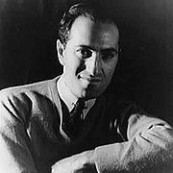





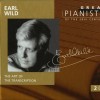
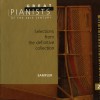
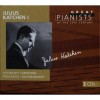
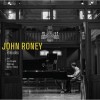
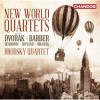
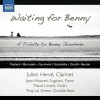
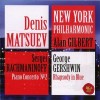

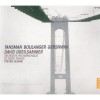

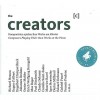

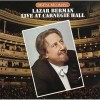
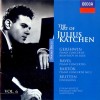
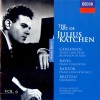

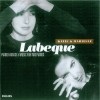
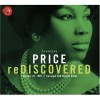
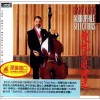
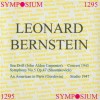


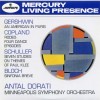

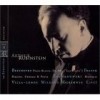
![The Heifetz Collection, Volume 19 [2 CD]](http://static.classicalm.com/repository/disk-cover/small/947-img1317413695600051.jpg)
